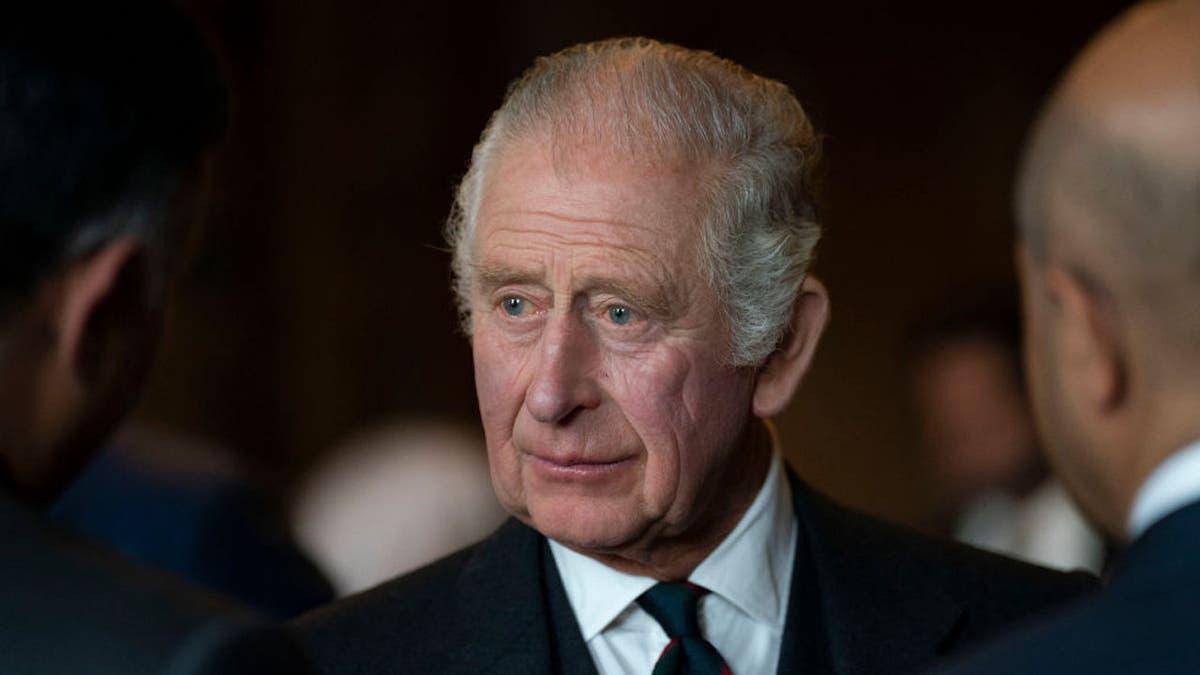Queen Camilla gives health update on King Charles after enlarged prostate diagnosis
Queen Camilla said King Charles is doing ‘fine’ ahead of his treatment for an enlarged prostate.
Even kings have prostate problems.
King Charles III was admitted on Friday to The London Clinic, a private hospital, where he underwent a scheduled procedure due to an enlarged prostate, Buckingham Palace confirmed.
The treatment was successful and the king is "doing quite well," a royal source told Fox News Digital.
The palace emphasized that his condition is non-cancerous.
KING CHARLES 'DOING QUITE WELL' AFTER SUCCESSFUL PROSTATE TREATMENT
Google searches for "prostate check" surged last week after the palace first disclosed the planned treatment, per multiple reports.
The 75-year-old British monarch hopes to encourage men who are experiencing symptoms to seek medical attention, according to royal experts.

King Charles III was admitted to the London Clinic private hospital where he underwent a scheduled procedure due to an enlarged prostate, Buckingham Palace confirmed on Friday. (Getty Images)
What is BPH?
Benign prostatic hyperplasia, or BPH, is a non-cancerous condition that occurs when the prostate becomes enlarged.
"We don’t know what causes some men to have larger prostates than others," Seth Bechis, M.D., associate professor of urology with the UC San Diego School of Medicine and urologist at UC San Diego Health, told Fox News Digital. (He was not involved in King Charles' care.)
KING CHARLES III TO UNDERGO 'CORRECTIVE PROCEDURE' NEXT WEEK FOR AN ENLARGED PROSTATE
"The prostate is one of the few organs in the human body that continues to grow during adulthood," he added.
As the prostate grows, the enlarged prostate tissue may compress the urethra, which is the tube that connects to the bladder that helps urine drain from the body.

The British monarch hopes to encourage men who are experiencing symptoms to seek medical attention, according to royal experts. (Getty Images)
BPH decreases the flow of urine through the urethra, making it more difficult to empty the bladder.
This may cause men to strain more when urinating.
Other common symptoms of BPH include urinating frequently, urinating at night, difficulty starting a urine flow, having a weak urine stream that stops and starts, dribbling at the end of urination and difficulty emptying the bladder.
Treatment for the condition
Urologists often use the American Urological Association (AUA) Symptom Index to help determine the treatment that is most appropriate, according to Johns Hopkins Medicine’s website.
It is also important for men to take an inventory of the type of fluid they're consuming.
The most conservative and least invasive approach is to implement simple lifestyle changes.
Some men may not realize the extent of their daily fluid intake, so simply avoiding drinking too much, especially before bed, can help relieve symptoms, according to Mayo Clinic.
NEW PROSTATE CANCER TREATMENT COULD BE ON THE HORIZON, SAY UK RESEARCHERS: ‘TREMENDOUSLY EXCITING’
It is also important for men to take an inventory of the type of fluid they're consuming, as drinking lots of caffeine and alcohol can make the condition worse, particularly at night.
If lifestyle modifications do not improve symptoms, the next step is taking medication to help open the passageway through the prostate so it’s easier for urine to drain, Mayo Clinic stated.

There are several procedures to treat an enlarged prostate, each with its own side effects and potential complications. (iStock)
Some medications, known as alpha-blockers, accomplish this by relaxing the muscles in the prostate, while another class, known as 5-alpha-reductase inhibitors, works by shrinking the prostate.
This medical treatment is often not as effective as surgery, however, the expert noted.
PROSTATE CANCER MYTHS AND COMMON MISCONCEPTIONS FROM AN ONCOLOGIST AMID HIGH-PROFILE CASES
There are several procedures to treat an enlarged prostate, each with its own side effects and potential complications.
It’s important to consider whether the procedure requires general anesthesia, if it preserves ejaculatory function and whether it involves a catheter, experts recommend.
Bechis reviewed several of the surgical options for Fox News Digital.
Prostatic urethral lift (UroLift)
The UroLift is performed in the office or operating room without general anesthesia.
"A camera (cystoscope) is inserted into the urethra and advanced to the level of the prostate," Bechis said.

It’s important to consider whether the procedure requires general anesthesia and whether it involves a catheter, experts recommend. (iStock)
Instead of cutting, heating or removing any tissue, the urologist uses special clips to hold the enlarged part of the prostate out of the way so the urine can drain more easily, according to Yale Medicine.
The procedure preserves ejaculatory function and does not require a catheter; but only a select group of patients are eligible based on prostate size and shape, according to Bechis.
Water vapor thermal therapy (Rezūm)
This procedure is performed in a doctor’s office or operating room. It does not require general anesthesia.
A camera is inserted into the urethra and advanced to the level of the prostate, where steam is injected to destroy obstructing tissue around the urethra, Bechis said.
"We don’t know what causes some men to have larger prostates than others."
"You will have a catheter in place after the surgery for [two to five] days and will continue an alpha-blocker medication, such as tamsulosin," he added.
Ejaculatory function is preserved for most patients, but recovery includes a placed catheter for several days and an alpha blocker.

There will be a projected 299,010 new cases of prostate cancer in the U.S. in 2024, and about 35,250 deaths, says the American Cancer Society (ACS). (iStock)
It can take up to three to six months to see maximal improvement in symptoms, according to Bechis.
Although this is a relatively new procedure with good reported outcomes, longer term data is not yet available, the doctor noted.
Photovaporization of the prostate (PVP)
"A cystoscope is inserted into the bladder through the urethra and a special laser is used to vaporize prostate tissue," Bechis said of this approach.
The procedure does not cut or scrape tissue, according to Mayo Clinic.
Because PVP results in much less bleeding, it’s a good option for those who take anticoagulation medications, Bechis added.
FLORIDA MEDICAL TECH COMPANY LAUNCHES NOVEL AI TEST FOR PROSTATE CANCER THERAPY
Patients will need to have a catheter in place after surgery and will likely stay one night in the hospital.
Possible complications include blood loss as well as infection, bladder injury or urine incontinence.
Waterjet therapy (aquablation)
With this approach, a cystoscope is inserted into the bladder through the urethra.
An ultrasound is then used to direct a focused water jet, which circumferentially destroys prostate tissue, Bechis said.
It’s fast and efficient, but relatively new — "so long-term outcomes are not fully collected yet," he noted.
"The prostate is one of the few organs in the human body that continues to grow during adulthood."
Men usually can preserve ejaculatory function after this procedure, but will have a catheter in place after surgery and will usually stay one night in the hospital.
Potential complications include blood loss, infection, bladder injury or incontinence of urine.
Transurethral resection of the prostate (TURP)
With this procedure, a camera is inserted into the bladder through the urethra.
A surgical instrument is then used to create an electric current that "chips away" at the prostate until the urethra is no longer obstructed, Bechis said.
The procedure is performed without any incisions.
CLICK HERE TO SIGN UP FOR OUR HEALTH NEWSLETTER
"You will have a catheter in place after surgery and stay one night in the hospital until the bleeding has stopped," Bechis said.
Possible complications include blood loss, infection, bladder injury or incontinence of urine.

After a robot-assisted laparoscopic prostatectomy, patients can expect to recover in the hospital for one to two days, with a catheter placed after surgery for seven to 10 days. (iStock)
As the bladder is "retrained" to void, the leakage of urine gradually decreases.
Robot-assisted laparoscopic prostatectomy
This procedure is often reserved for larger prostates.
"This is a more involved surgery that goes through the abdomen, with risk of complications including need for blood transfusion, injury to bowel or abdominal structures, or bladder leak," Bechis said.
During this procedure, multiple small incisions are made in the abdomen and small robotic instruments are used to remove the prostate through an incision in the bladder, the doctor said.
Patients can expect to recover in the hospital for one to two days, with a catheter placed after surgery for seven to 10 days, according to Bechis.
CLICK HERE TO GET THE FOX NEWS APP
There will be a projected 299,010 new cases of prostate cancer in the U.S. in 2024, and about 35,250 deaths, according to the American Cancer Society (ACS).
Stephanie Giang-Paunon of Fox News Digital contributed reporting.

